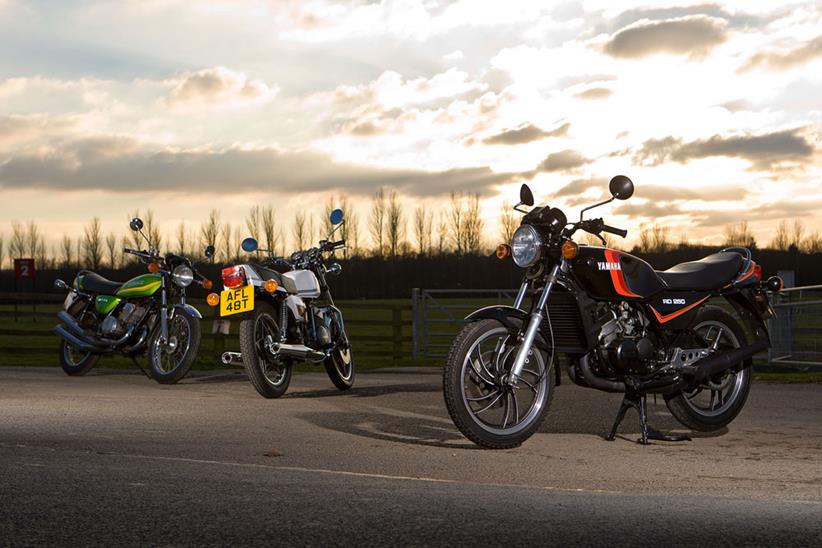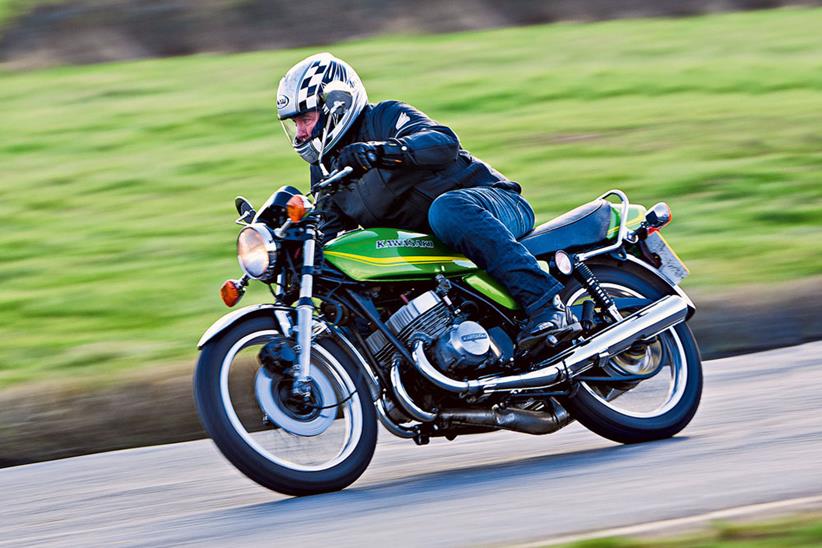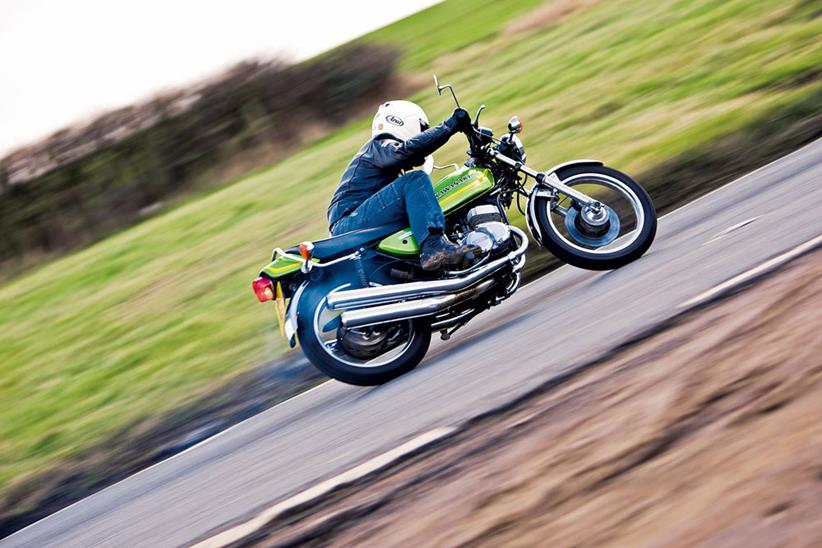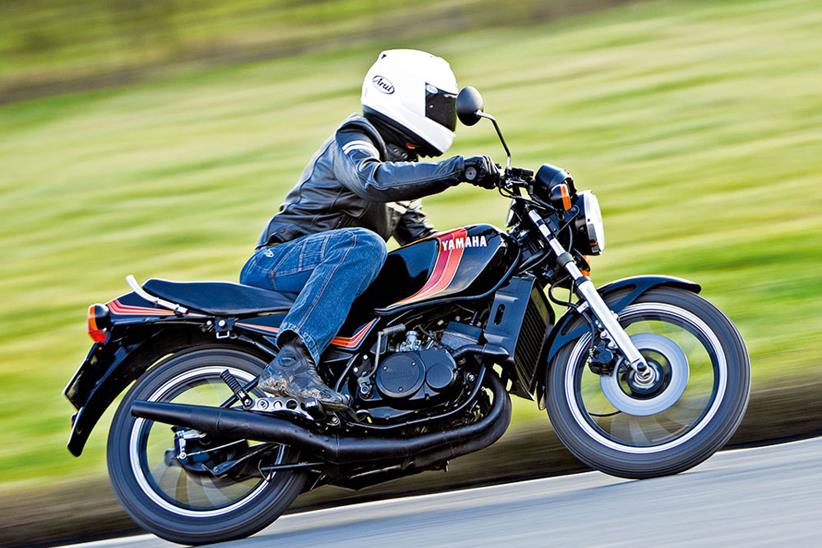Quarter-litre heroes from before the fall: Kawasaki KH250 v Suzuki GT250 v Yamaha RD250 LC
The Yamaha RD250LC, Suzuki GT250 X7 and Kawasaki KH250 shrugged off the 125cc learner laws and are now more sought after than ever
![]() Politicians, eh? If they’re not cooking the books on their expense claims, they’re spoiling the fun for the next generation of learner motorcyclists. In 2011, we’ve got the two-part test, two-stage licences – and too few test centres. Back in 1981, our friends in Westminster had just served notice that, from October the following year, learner riders would have to sit their two-wheeled apprenticeships on 12bhp 125s instead of 250s with three times the power.
Politicians, eh? If they’re not cooking the books on their expense claims, they’re spoiling the fun for the next generation of learner motorcyclists. In 2011, we’ve got the two-part test, two-stage licences – and too few test centres. Back in 1981, our friends in Westminster had just served notice that, from October the following year, learner riders would have to sit their two-wheeled apprenticeships on 12bhp 125s instead of 250s with three times the power.
It was a move that put the skids under one of the most important and competitive sectors of the motorcycle market, and one that put a temporary end to the cult of the 250 stroker.
Up until the changes to the UK’s learner laws were announced, the 250 class was red hot. True, Honda had been playing it safe with a range of four-stroke twins that sold well, without ever threatening anyone’s adrenal glands. The only way Honda’s CB250T Dream and CB250N Superdream would raise the pulse rate of any self-respecting teen hooligan in the late ’70s or early ’80s was if they rode one off the edge of a cliff. But Suzuki, Yamaha and Kawasaki – ah, that was a different matter.
Fast, furious and fun, their quarter-litre strokers delivered serious performance that could whet the appetite for a lifetime addiction to two wheels. Obviously, that would never do.
Kawasaki had their KH250 triple – evolved out of the 1973 S1 and with a strong family tie to the infamous H1 and H2. Suzuki had refined their twin-cylinder GT twins into the ultra-lightweight GT250 X7 and Yamaha had brought the race-winning technology from their all-conquering TZ racers to the road in the shape of the liquid-cooled RD250 LC. Learner riders never had it so good. For a while, at least.
![]() Kawasaki KH250
Kawasaki KH250
THE KH250 can trace its roots back to 1971, when Kawasaki added the 249cc S1 to its two-stroke triple range. Sitting alongside the S2 350 and fearsome H1 500/H2 750 pairing, the S1 (launched worldwide in ’72 and tagged the Mach 1 in North America) was billed as the most powerful 250 of its day. Producing a claimed 32bhp at 8000rpm and reportedly capable of 98mph, the S1 seemed to deliver the figures to match the hype.
Over the following three years the S1 evolved into the S1A, B and C – losing 4bhp and much of the rawness that made the original bike so exciting as American emissions laws pulled ever tighter – until for ’76 it metomorphosised into the even more refined KH250 A5.
Early quarter-litre KHs retained the twin-leading-shoe front drum of the S1, but a revised B1 model with disc front stopper appeared later in the year. Claimed power remained the same, but a broader spread of what was available made the KH easier to ride. Dry weight increased 4kg, knocking top speed back to just under 90mph.
The KH we have here is a standard, unrestored 1978 B3 which benefits from the revised front brake mastercylinder introduced that year. From ’78 to its final stand in 1980 the KH changed little, so a B3 is as refined as the little triple got. Despite being a decade behind the X7 and LC in terms of design, KH250s remained a popular choice with novice riders up until the 125 learner law’s introduction in ’82, so for a while at least it competed directly with its Suzuki and Yamaha rivals. But can the three-cylinder Kawasaki really hold its own?
I didn’t have to wait long to find out on our test, after editor Jim (Moore) and racer Rob (Hoyles) snatched the keys to the X7 and LC respectively, leaving me to prod the KH into life with a lazy swing of the – rather long – kickstarter. I’m soon smiling, though, when rewarded by that unique (in this class) burble as the piston-ported triple beneath me fires up first kick. Rob, meanwhile, flails away at a reluctant LC. Eventually the RD cracks into life and we head off to the nearest petrol station to juice all three bikes – an exercise that leaves PS’s finances lighter to the tune of 48 quid. Knowing how thirsty these sporty strokers can be those tanks won’t be full for long.
I feel immediately at home on the KH. There’s plenty of torque on tap from idle to make town riding a breeze and the wide ’bars make threading through traffic almost pleasurable. A relatively long wheelbase (1372mm compared to the Suzuki’s 1310) keeps the triple stable at speed but, flicking through the interminable series of roundabouts on the way out of town, the Kawasaki is noticeably slower to turn-in than either the Suzuki or the Yam. But sling-shotting out is an altogether different matter. The bottom-end urge of the KH, combined with low overall gearing, allows it to keep pace with its more technically advanced competition up to 40mph. Soon every set of traffic lights becomes the start of a drag race.
![]() It’s almost as if Kawasaki engineers designed the KH with sprinting between lights in mind. Stable in a straight line: check. Easy to get off the line: check. Looks good reflected in a shop window: check. Period road tests show the KH to be about a second slower than the other two over the quarter, but over 100-200 yards the little triple isn’t far behind them.
It’s almost as if Kawasaki engineers designed the KH with sprinting between lights in mind. Stable in a straight line: check. Easy to get off the line: check. Looks good reflected in a shop window: check. Period road tests show the KH to be about a second slower than the other two over the quarter, but over 100-200 yards the little triple isn’t far behind them.
At higher speeds, however, the KH shows its age. Real power doesn’t kick in until 6500rpm. From there, it runs into its 8500rpm redline in the blink of an eye. But that’s the trade-off with piston porting.
Even with relatively small 26mm carburettors helping to boost bottom-end urge, if you want a decent top end, you have to port the engine accordingly – and accept that you’ll have to keep the motor spinning high and hard. That’s usually a given on any small stroker, but the KH can get vibey – in fact at 6000rpm there’s enough vibration to almost rattle my feet off the ’pegs.
The suspension is a bit harsh, too, the controls feel clumsy and dated, the brakes are mediocre at best, and the footrests are too far forward to be truly sporty. And while I’ve no reason to doubt the period road test top-speed figure of 88.7mph, there’s no escaping the fact that the KH is appreciably slower than either the X7 or the LC in the real world. On paper, they’re both over 10mph faster. But in the Kawasaki’s defence its design and engineering are from an earlier era, and in isolation it remains great fun to ride.
What the KH delivers is a real visceral riding experience. It’s raw, exhilarating and exciting – and it attracted the most attention of all three test bikes. Everyone we met seemed to have good memories of the KH250.
Whatever its shortcomings in this company – and they’re really only down to its older design – the KH has character in spades. Before the X7 and LC, the KH easily held its own in the 250 class against the GT250 and air-cooled RD. It’s just that by 1978 its development had been neglected – a casualty of Kawasaki’s emerging four-stroke range and an increasingly emissions-led US market.
But there’s no denying that there’s something very special about a two-stroke triple, and in terms of looks, at least, the KH has both the X7 and LC well and truly beat.
![]() Suzuki GT250 X7
Suzuki GT250 X7
Suzuki’s GT250 X7 is the ultimate expression of the air-cooled 250 sports bike. Launched in 1978 it instantly became the fastest 250 on the streets. Motorcycle Mechanics’ jockey-like test rider Brian Crichton – lying flat on the tank – squeezed 99.5mph out of the first test bike to reach our shores. Removing the mirrors yielded an extra 1mph, making the X7 the first genuine 100mph 250 in the UK.
Mechanically, it’s not a radical departure from the late ’60s T250 Super Six. The secret of the X7’s speed is not a huge leap forward in engine technology, but rather a crash diet. At only 128kg, the X7 is a staggering 18kg less than the GT250B and C models it replaced, and a whopping 23.5kg lighter than Yamaha’s air-cooled RD250. Adopting a single downtube frame over the older GT’s twin downtube layout shaved almost 1.5kg from the X7’s chassis, and its ultra-compact engine weighs 7.3kg less than the ‘old’ GT250B/C mill.
That’s not to say Suzuki ignored the engine’s internals. Over the years, the firm’s 250s had become gradually more peaky in their delivery. But the X7 reversed this trend, producing its power in a much more user-friendly way, while still retaining a strong top-end rush. This was achieved with relatively conservative porting and smaller carbs (26mm instead of 28mm) to strengthen midrange performance, plus the adoption of a dual induction system, pioneered on Suzuki’s off-road range. The system utilises mild piston porting to boost low down and mid-range power, with reed-valve induction taking over at higher revs to deliver strong top-end performance.
The X7’s combination of power and light weight worked brilliantly and the bike was virtually the same from 1978 until it made way for the RG250 Gamma in 1983. In five years all that changed were its colours and graphics, and a switch to rectangular indicators and a one-piece clock housing in 1980.
Ride a good X7 today and it’s immediately clear what a potent little package it is, and why it was so popular with 17 year-olds of the time. For this test I’m riding a 1978 N model (complete with genuine Suzuki crash bars) owned and restored by PS friend Gary Haythorn. It’s truly fabulous and as near to a brand-new X7 as you’re likely to find.
Despite both being 250s, the Suzuki and Kawasaki KH couldn’t feel more different. Compared to the KH250, the X7 feels tiny – and so, so light. Like a 125. The Kawasaki gives away a staggering 30kg to the GT, and three extra inches in wheelbase, so it’s little wonder the Suzuki feels much more compact. Add the slim profile and low seat compared to the high, wide KH and the pair feel like bikes of different capacities, not just different manufacturers.
Hustling down a winding back road the Suzuki’s lack of bulk becomes more apparent. At first it takes me by surprise, flicking into bends faster than my brain expects. At times, it feels like the front end is going to tuck under, although I suspect this has more to do with the bike’s rock-hard Cheng Shin tyres than any inherent handling trait. The soft suspension, too, feels overwhelmed at times, but things never actually get out of hand. And I don’t suppose Suzuki had 15-stone riders in mind when they designed the bike…
By the time I’ve got a few more miles under my belt, the X7’s handling and I have come to some sort of honourable truce and I begin to revel in the quick steering and light weight of the bike. Once I get the knack of going a bit deeper into turns before tipping the X7 in, things get a lot easier – and more enjoyable. There’s still a slightly skittish feel to the bike and the faster I go, the more lively the ride gets. But I’m sure that with more miles I’d love the sharp handling.
![]() By contrast, I love the engine straight away. Even with the standard pipes, it has a delicious two-stroke crackle and the way the motor spins up so quickly is a delight. The lightened internals that helped cut the overall weight of the bike are apparent from the off. Keeping the revs – and speed – up is so easy.
By contrast, I love the engine straight away. Even with the standard pipes, it has a delicious two-stroke crackle and the way the motor spins up so quickly is a delight. The lightened internals that helped cut the overall weight of the bike are apparent from the off. Keeping the revs – and speed – up is so easy.
It’s only when we hit a long uphill drag that the engine’s lack of torque becomes an issue. At the bottom of the incline I blast past fellow tester Rob on the KH. The X7 is appreciably faster than the Kawasaki. But as the incline steepens, Rob looms larger in my mirrors and I down-change too late to stop him easing past as I struggle to get back into the powerband.
In the hands of a sub-12 stone rider an X7 would be a formidable weapon against even the LC. From 7000rpm the motor takes off, and keeps making power all the way to the 8500rpm redline. The Suzuki engine responds well to tuning – Brian Crichton coaxed 118mph out of his fettled racer.
But the best thing about the X7 is the way it makes me feel. I love the sound, the power delivery and – once I’d got used to it – the almost telepathic way it changes direction. The front brake could be a bit sharper and the suspension a bit firmer but otherwise it’s a great package. I kept hearing this voice in my head saying “…I could have gone a bit quicker through that corner – must get it right next time…” That’s what these old-school 250s are all about. And as quarter-litre strokers of this vintage go, the X7 is definitely one of the best.
![]() Yamaha RD250 LC
Yamaha RD250 LC
We’ve probably been a bit unfair to both the Kawasaki KH250 and the Suzuki X7 by pitting them against Yamaha’s RD250 LC. After all, the LC didn’t appear until 1980 – a full two years after the X7 and five years on from the S1’s metamorphosis into the KH250. But both the Suzuki and the Kawasaki were both still current models when the LC hit the showrooms, and magazines of the period pitted the three bikes against each other.
When the RD250 LC went on sale in 1980, it was obvious even then that the liquid-cooled, TZ-inspired heir to the quarter-litre class throne was going to be an instant classic. Just as the 100mph X7 raised the bar two years earlier, the LC raised it yet again. In May 1980, the first RD250 LCs arrived in the UK, having been developed in tandem with the 350LC. The 350 was a month later going on sale in Britain, due to production difficulties at the factory, so the 250 got the first chance to make an impression. And what an impression.
At first glance, the RD250 LC looked a lot like the 350 – a bonus to learner riders – with the single disc and horn, and sidepanel stickers being the only give-aways. With a claimed 35bhp, the 250LC promised exceptional performance and up-to-the-minute handling from its MX and GP-inspired cantilever monoshock rear suspension.
Despite costing over £1000 when you could buy a Kawasaki KH250 for around £300 less, there were no shortage of takers for the LC.
There’s no doubting that Yamaha got it pretty well right first time, with changes to the RD250 LC being remarkably few throughout its time in Yamaha’s range. Apart from colours and changes to the exhaust after early examples cracked, the only significant update was the rubber damper rods added under the engine for 1982 to curb vertical movement. So I fully expect this late (1986) low-mileage German import LC, for sale at Chequered Flag Bike Sales for £3495, to deliver. Interestingly, despite 250s no longer being learner legal after ’82, and not one 250LC being sold in Britain in 1983, the Elsie’s strongest year for sales in the UK was 1985, with 1466 sold.
Remembering to flip up the right-side footrest before kick starting the LC brings the memories flooding back. I was working in the bike trade when the LC was launched and, even though the smaller twin was ‘only’ a 250, I remember the excitement of getting a quick blast on one of the first bikes delivered. Chasing Jim and Rob round on the black, red and gold ‘Mars Bar’ LC feels almost as good.
Thanks to its water jacket, the LC has a quieter running engine than the two air-cooled machines. But there’s a certain understated menace to the business-like crackle from the exhausts, that sharpens to a hard edged wail as the revs build. It’s an addictive sound – instantly recognisable as a Yamaha two-stroke twin, made all the more pleasurable with the fitment of a pair of spannies.
Standard, tidy nick LC exhausts are now rare, despite them once being the first thing any self-respecting LC owner replaced, so running spannies is also a good way keep your stock pipes in tip-top condition.
The slick six-speed gearbox makes it a pleasure to keep the motor spinning over 6000rpm – right in the heart of the power. And the riding position feels much more modern than the others. Slightly rear-set footrests and low-ish ’bars tip me into the perfect stance to enjoy the LC’s potential.
There’s no getting away from it, the LC is a lot faster than the X7 – and significantly quicker than the KH. But not just on paper. It’s a lot easier to ride faster where it counts – on the road. Maybe that’s not so surprising with an extra 6.5bhp over the, admittedly lighter, X7, but the ease with which I can pull away from the other two bikes shows that two extra years of development weren’t wasted. Kept in the powerband, the LC romps away. On the twisting minor roads we’re riding, there won’t be many 30-year-old bikes of any capacity – except a 350LC – that could see off this little Yamaha.
![]() Handling, too, shows the advantage of an extra two years of development. Sure, by modern standards the LC feels primitive, with the spindly 32mm forks flexing and diving under braking, but the back end feels pretty supple and the ride is reassuring.
Handling, too, shows the advantage of an extra two years of development. Sure, by modern standards the LC feels primitive, with the spindly 32mm forks flexing and diving under braking, but the back end feels pretty supple and the ride is reassuring.
There’s less of the skittishness that’s apparent aboard the X7, and the LC offers much more of a big-bike feel compared to the X7’s 125-on-steriods dimensions. I’d feel happier about pushing the LC to its limits than either of the other two – even if the front brake feels underwhelming.
The extra performance doesn’t come at the expense of refinement or build quality. Gary Haythorn’s restored X7 is better finished than any bike that rolled off the Suzuki production line in the late ’70s, but the Yam’s factory finish isn’t that far behind. It’s a well put together bike with everything in the right place.
There’s something special about riding a 250 stroker from what was arguably the golden age of the genre. Maybe it’s a nostalgia thing, maybe it’s about turning the clock back. But whatever it is, it’s a real blast. The RD250 LC is light, uncomplicated, fast(ish) and easy to sling about – all virtues I can highly recommend in a bike. And it brings a great big, silly grin to your face – guaranteed.
![]() Conclusion
Conclusion
Four years is a long time in motorcycle development – and it shows with our three 250 strokers. While the Kawasaki KH250 remains great fun to ride, the difference between it and the other two bikes in practical terms is enough to keep it in third place.
The KH handles predictably and the torque from its three-cylinder engine makes it the best bet in traffic and easiest to get off the line quickly. If pose factor was the main criterion though, the Kwack would edge it.
More people commented on the look and sound of the Kawasaki than either of the other machines – and plenty even hung around to hear it being fired into life. On the road, though, it lagged just too far behind the younger Suzuki and Yamaha.
The battle for the top spot was fierce. The beautifully restored Suzuki is the bike that everyone wanted to take home. Its crisp engine, laughably light weight and oh-so-sharp steering make it all as an air-cooled sports 250 should be. The provenance of the X7’s ‘first 100mph 250…’ tag has been debated over and over again – although as the figure was recorded by an ex-editor of our sister title, Classic Bike, we’re happy to accept its veracity. In 1978, when the X7 was launched, it was hard to imagine any 250 could ever be better.
Two years later, however, it was bettered. The RD250 LC was the closest thing to a TZ racer on the road that anyone had seen. Here was the real 100mph-plus deal, with liquid-cooling and a monoshock.
On the road, the LC was that bit better than either of its competitors in every respect. A lot faster and with a more planted feel than the flighty X7, it looks – and feels – light years ahead of the traditionally styled KH250.
The LC rewrote the 250 class rule book in 1980 – undoubtedly contributing to their demise in the UK when the powers that be took exception to learners on 100mph missiles. It remains the pick of its generation today. Fast, smooth and with charisma by the barrowload, the LC is the best of the bunch.
Words Gerard Kane Photos Rory Game














